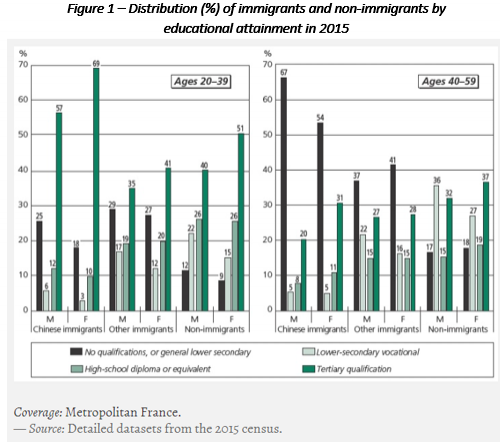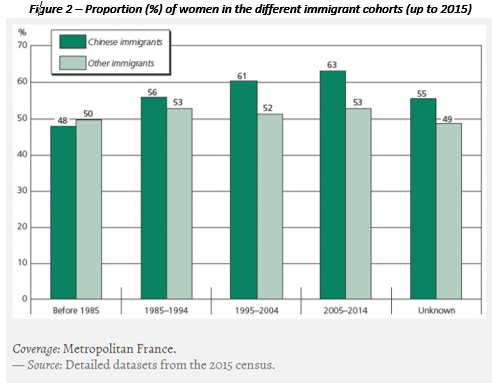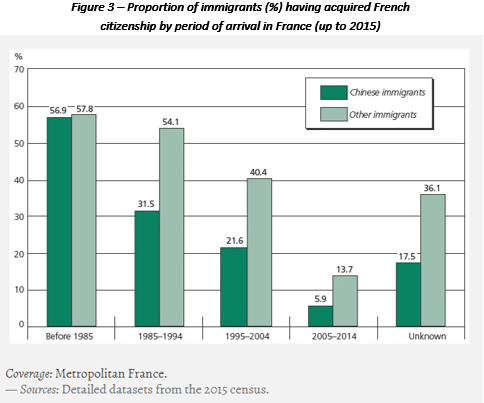Chinese immigration in France
According to INSEE, France now has slightly over 100,000 immigrants of Chinese origin. The economic dynamism of this population is often emphasized. However, we still have relatively little quantitative knowledge about immigration from China to France, which began in the early twentieth century and has been growing for the last 40 years. The Lunar New Year, commonly called “Chinese New Year,” offers an occasion for clarifying the sociodemographic characteristics of this population group thanks to an article by INED senior researcher Isabelle Attané, a specialist of demography in China.
Chinese immigrants heavily concentrated in Île-de-France
Chinese immigrants mainly reside in a few neighborhoods in Paris (Belleville in the 20th arrondissement, the “Choisy Triangle” in the 13th arrondissement, the northern 19th arrondissement) and a number of townships in the Seine-Saint-Denis department (Seine-Saint-Denis, Aubervilliers, Bobigny, Pantin, Bagnolet, and La Courneuve). This highly unequal distribution distinguishes them from the other main immigrant groups in France, who have settled more widely across the country. It also means that Chinese immigrant visibility swings from quite high in the public space of some of these areas (especially for business activity) to near invisibility in a number of French regions, with particularly high student populations. France’s 2017 census indicates that two out of three Chinese immigrants (66%) live in Île-de-France, as against slightly over one in three for other immigrants (38%) and 17% of native French. Sixty percent (60%) of Chinese immigrants living in Île-de-France reside in Paris and Seine-Saint-Denis department (as against 39% of other immigrants living in Île-de-France).
Sixty-four percent (64%) of Chinese nationals admitted for residence in France are students
In 2017, students represented 64% of all Chinese nationals admitted for residence, as against 28% of all other foreign nationals taken together. Young people who come to France to study are mostly from privileged social backgrounds and usually have few ties with other Chinese immigrants.
The increasing presence of Chinese students in France is part of a worldwide trend, as China is now the first source of international students. France recently established a program there for promoting its higher education system, and in 2015 it was ranked 8th for number of Chinese students hosted throughout the world and 3rd among non-English-speaking countries, behind Japan and South Korea.

An increasingly educated population
On average, Chinese immigrants throughout the world have higher educational attainment than both immigrants from other foreign countries and natives in receiving countries. While in the United States and Canada this is due in part to selective migration policies, a similar phenomenon is observed in France, where the proportion of adults aged 20 to 59 with a higher education degree is greater among Chinese immigrants (50%) than other immigrants (32%) and native French (40%). The overrepresentation of Chinese migrants in this educational attainment category is due to the aforementioned fact that students represent a high proportion of total Chinese migration to France (Figure 1).
More women
Chinese immigrants are also distinguished by an overrepresentation of women (60% in 2017, as against 51% of immigrants from other countries: Figure 2). This is due to increasingly feminized entry flows of Chinese nationals: the proportion of women admitted for residence in France rose from 56% in 1999 to 62% in 2017.
Additionally, the Chinese immigrant population is relatively young. While the proportion of children under 15 is low and equal to that for other immigrants (under 5%, as against 20% of the French-born), young adults are heavily overrepresented (54% of Chinese immigrants in 2017 were between the ages of 20 and 39 in 2017, as against 29% of other immigrants and 23% of non-immigrants. Again, this is due in particular to the strong presence of Chinese international students.

Chinese immigrants acquire French citizenship at half the rate of other immigrants
Only 19% of Chinese immigrants have acquired French nationality—half as many as other immigrants (40%) (Figure 3). The high proportion of recent Chinese arrivals compared to other immigrants (21% and 11% respectively over the 2010-2014 period) may explain part of this disparity. It may also be due to the overrepresentation of Chinese students, a category less inclined to settle durably in France than people who have migrated for economic or family reasons. It may also have to do with the predominance of immigrants from Wenzhou, who maintain particularly strong ties to their Chinese region of origin and may therefore have relatively short-term migration plans. Moreover, China does not permit dual nationality, and Chinese may be less inclined than other foreigners to give up the nationality they were born with.

Isabelle Attané, 2022, Chinese Immigration to France, Population (English edition) 217-248.
On line January 2023, the 19th

